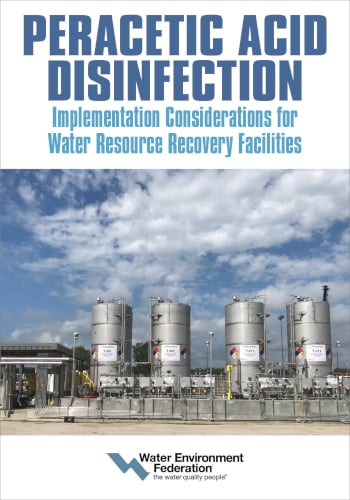Our latest technical publication, Peracetic Acid Disinfection: Implementation Considerations for Water Resource Recovery Facilities, aims to bridge the knowledge gap about the value of peracetic acid as a wastewater and stormwater disinfectant. The handbook's lead author, Dr. Kati Bell, offers insights.
Why did the authors write this publication?
KB: Although peracetic acid (PAA) has been used for wastewater effluent disinfection or over two decades in Europe, it only recently has been applied for municipal wastewater disinfection, and in only a handful of facilities in North America. While the first commercial PAA product approved for use in the United States by the EPA was in 2006, with the first application in 2012, this technology has been out of reach for most utilities in North America. Seeing the need to fill a knowledge gap in our industry, I proposed development of this document, in partnership with other experts in the field to inform utilities, regulators, engineers, operators and regulators about the applicability of the technology along with the challenges that must be overcome for more widespread implementation of PAA.
What do you want the water sector to know about this publication?
KB: This publication was a collaboration among utilities, engineers, operators, PAA manufacturers and regulators and reflects a breadth of perspectives and represents a wealth of knowledge that has been compiled in a single document. While there is still a need to build upon the information provided in this document, it is a major step forward in the collection of practical experience and case studies on the testing, design, permitting, construction, and operations of a PAA system for wastewater disinfection compliance. It was an honor to work with the authors, reviewers and WEF editorial staff on this document to help advance use of this important technology.
What advice can you provide to readers?
KB: Peracetic acid is not a silver bullet for addressing all wastewater disinfection applications, but it is a valuable tool that we have in our toolbox that can be used under the appropriate circumstances. For some wastewater resource recovery facilities where other, more mature technologies like chlorination/chloramination or UV cannot be applied. In some facilities, chlorination/chloramination can yield challenges with disinfection by-products with discharge limits that are increasingly stringent; and in some facilities low UV transmittance or suspended solids above 10 mg/L can limit use of the technology. In these cases, PAA could address these challenges while being economically competitive. The document can be used to help guide an informed discussion on whether PAA could be a viable solution when site-specific factors are considered.
For more information on Peracetic Acid Disinfection: Implementation Considerations for Water Resource Recovery Facilities, visit WEF’s online store.



 Dr. Kati Bell is Director of Water Strategy for Brown and Caldwell and she has over 25 years of experience with project work that exceeds 5 billion gallons per day (BGD) of treatment capacity, globally. She is responsible for leading Brown and Caldwell’s Applied Research and Innovation Strategy that is aligned with advancing innovation in all of the market sectors that Brown and Caldwell serves. She is also responsible for setting the vision and mission for the Brown and Caldwell Treatability Laboratory and leading global partnerships with strategic research partners in collaboration with Brown and Caldwell’s technical leaders to advance applied research and leverage innovative solutions for clients.
Dr. Kati Bell is Director of Water Strategy for Brown and Caldwell and she has over 25 years of experience with project work that exceeds 5 billion gallons per day (BGD) of treatment capacity, globally. She is responsible for leading Brown and Caldwell’s Applied Research and Innovation Strategy that is aligned with advancing innovation in all of the market sectors that Brown and Caldwell serves. She is also responsible for setting the vision and mission for the Brown and Caldwell Treatability Laboratory and leading global partnerships with strategic research partners in collaboration with Brown and Caldwell’s technical leaders to advance applied research and leverage innovative solutions for clients.